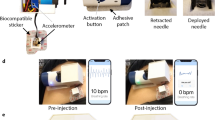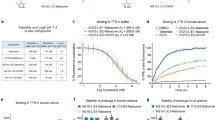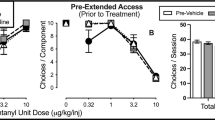Abstract
Opioid misuse is at historically high levels in the United States, with inhalation (ie, smoking and vaping) being one of the most common routes of consumption. We developed and validated a novel preclinical model of opioid self-administration by inhalation that does not require surgery and reliably produces somatic and motivational signs of dependence. Rats were trained to perform an operant response (nosepoke) to receive 10 s of vaporized sufentanil, a potent opioid, in 2 h daily sessions. Rats readily and concentration-dependently self-administered vaporized sufentanil. Rats exhibited a significant increase in responding for sufentanil when given the preferential μ-opioid receptor inverse agonist naloxone, suggesting the participation of μ-opioid receptors in the reinforcing properties of sufentanil vapor. Serum sufentanil concentrations significantly correlated with the number of sufentanil vapor deliveries. Rats that were given long access (LgA; 12 h/day) but not short access (ShA; 1 h/day) to vaporized sufentanil escalated their drug intake over time and exhibited both naloxone-precipitated somatic signs of opioid withdrawal and spontaneous withdrawal-induced mechanical hypersensitivity. After 6 months of forced drug abstinence, LgA rats returned to pre-escalation baseline levels of responding for sufentanil and mechanical sensitivity. Upon subsequent re-escalation (ie, after the return to extended access to sufentanil vapor), LgA rats again developed naloxone-precipitated somatic signs of withdrawal and spontaneous withdrawal-induced mechanical hypersensitivity. These findings demonstrate that the operant sufentanil vapor self-administration model has both face and construct validity and therefore will be useful for investigating the neurobiological basis of opioid addiction.
Similar content being viewed by others
Log in or create a free account to read this content
Gain free access to this article, as well as selected content from this journal and more on nature.com
or
References
Ahmed SH, Walker JR, Koob GF (2000). Persistent increase in the motivation to take heroin in rats with a history of drug escalation. Neuropsychopharmacology 22: 413–421.
Barbier E, Vendruscolo LF, Schlosburg JE, Edwards S, Juergens N, Park PE et al (2013). The NK1 receptor antagonist L822429 reduces heroin reinforcement. Neuropsychopharmacology 38: 976–984.
Célèrier E, Laulin JP, Corcuff JB, Le Moal M, Simonnet G (2001). Progressive enhancement of delayed hyperalgesia induced by repeated heroin administration: a sensitization process. J Neurosci 21: 4074–4080.
Centers for Disease Control and Prevention (CDC) (2008). Nonpharmaceutical fentanyl-related deaths—multiple states, April 2005-March 2007. MMWR Morb Mortal Wkly Rep 57: 793–796.
Chaplan SR, Bach FW, Pogrel JW, Chung JM, Yaksh TL (1994). Quantitative assessment of tactile allodynia in the rat paw. J Neurosci Methods 53: 55–63.
Cooper ZD, Truong YN-T, Shi Y-G, Woods JH (2008). Morphine deprivation increases self-administration of the fast- and short-acting mu-opioid receptor agonist remifentanil in the rat. J Pharmacol Exp Ther 326: 920–929.
Dowell D, Haegerich TM, Chou R (2016). CDC Guideline for Prescribing Opioids for Chronic Pain - United States, 2016. MMWR Recomm Rep 65: 1–49.
Edwards S, Vendruscolo LF, Schlosburg JE, Misra KK, Wee S, Park PE et al (2012). Development of mechanical hypersensitivity in rats during heroin and ethanol dependence: alleviation by CRF1 receptor antagonism. Neuropharmacology 62: 1142–1151.
Evans CJ, Cahill CM (2016). Neurobiology of opioid dependence in creating addiction vulnerability. F1000Research 5 (F1000 Faculty Rev) 1748.
Frank RG, Pollack HA (2017). Addressing the fentanyl threat to public health. N Engl J Med 376: 605–607.
Gasior M, Bond M, Malamut R (2016). Routes of abuse of prescription opioid analgesics: a review and assessment of the potential impact of abuse-deterrent formulations. Postgrad Med 128: 85–96.
Herning RI, Jones RT, Bachman J, Mines AH (1981). Puff volume increases when low-nicotine cigarettes are smoked. Br Med J Clin Res Ed 283: 187–189.
Jaffe AB, Sharpe LG, Jaffe JH (1989). Rats self-administer sufentanil in aerosol form. Psychopharmacology (Berl) 99: 289–293.
Juarez-Portilla C, Kim RD, Robotham M, Tariq M, Pitter M, LeSauter J et al (2017). Voluntary inhalation of methamphetamine: a novel strategy for studying intake non-invasively. Psychopharmacology (Berl) 234: 739–747.
Kenny PJ, Chen SA, Kitamura O, Markou A, Koob GF (2006). Conditioned withdrawal drives heroin consumption and decreases reward sensitivity. J Neurosci 26: 5894–5900.
Kintz P, Villain M, Dumestre V, Cirimele V (2005). Evidence of addiction by anesthesiologists as documented by hair analysis. Forensic Sci Int 153: 81–84.
Koob GF, Buck CL, Cohen A, Edwards S, Park PE, Schlosburg JE et al (2014). Addiction as a stress surfeit disorder. Neuropharmacology 76 Pt B: 370–382.
Koob GF, Pettit HO, Ettenberg A, Bloom FE (1984). Effects of opiate antagonists and their quaternary derivatives on heroin self-administration in the rat. J Pharmacol Exp Ther 229: 481–486.
Lenoir M, Ahmed SH (2007). Heroin-induced reinstatement is specific to compulsive heroin use and dissociable from heroin reward and sensitization. Neuropsychopharmacology 32: 616–624.
Lenoir M, Ahmed SH (2008). Supply of a nondrug substitute reduces escalated heroin consumption. Neuropsychopharmacology 33: 2272–2282.
Nguyen JD, Aarde SM, Cole M, Vandewater SA, Grant Y, Taffe MA (2016a). Locomotor stimulant and rewarding effects of inhaling methamphetamine, MDPV, and mephedrone via electronic cigarette-type technology. Neuropsychopharmacology 41: 2759–2771.
Nguyen JD, Aarde SM, Vandewater SA, Grant Y, Stouffer DG, Parsons LH et al (2016b). Inhaled delivery of Δ(9)-tetrahydrocannabinol (THC) to rats by e-cigarette vapor technology. Neuropharmacology 109: 112–120.
Panlilio LV, Katz JL, Pickens RW, Schindler CW (2003). Variability of drug self-administration in rats. Psychopharmacology (Berl) 167: 9–19.
Park PE, Schlosburg JE, Vendruscolo LF, Schulteis G, Edwards S, Koob GF (2015). Chronic CRF1 receptor blockade reduces heroin intake escalation and dependence-induced hyperalgesia. Addict Biol 20: 275–284.
Park PE, Vendruscolo LF, Schlosburg JE, Edwards S, Schulteis G, Koob GF (2013). Corticotropin-releasing factor (CRF) and α 2 adrenergic receptors mediate heroin withdrawal-potentiated startle in rats. Int J Neuropsychopharmacol 16: 1867–1875.
Schlosburg JE, Vendruscolo LF, Bremer PT, Lockner JW, Wade CL, Nunes AAK et al (2013). Dynamic vaccine blocks relapse to compulsive intake of heroin. Proc Natl Acad Sci USA 110: 9036–9041.
Schmeichel BE, Barbier E, Misra KK, Contet C, Schlosburg JE, Grigoriadis D et al (2015). Hypocretin receptor 2 antagonism dose-dependently reduces escalated heroin self-administration in rats. Neuropsychopharmacology 40: 1123–1129.
Vendruscolo LF, Schlosburg JE, Misra KK, Chen SA, Greenwell TN, Koob GF (2011). Escalation patterns of varying periods of heroin access. Pharmacol Biochem Behav 98: 570–574.
Wade CL, Kallupi M, Hernandez DO, Breysse E, de Guglielmo G, Crawford E et al (2017). High-frequency stimulation of the subthalamic nucleus blocks compulsive-like re-escalation of heroin taking in rats. Neuropsychopharmacology 42: 1850–1859.
Wade CL, Vendruscolo LF, Schlosburg JE, Hernandez DO, Koob GF (2015). Compulsive-like responding for opioid analgesics in rats with extended access. Neuropsychopharmacology 40: 421–428.
Weeks JR, Collins RJ (1976). Changes in morphine self-administration in rats induced by prostaglandin E1 and naloxone. Prostaglandins 12: 11–19.
Weinhold LL, Sharpe LG, Jaffe JH (1993). Housing conditions influence acquisition of sufentanil aerosol self-administration in rats. Pharmacol Biochem Behav 44: 141–144.
Wilkerson RG, Kim HK, Windsor TA, Mareiniss DP (2016). The opioid epidemic in the United States. Emerg Med Clin North Am 34: e1–e23.
Acknowledgements
We thank Michael Arends for editorial assistance and Dr Carrie Wade for helpful comments on an earlier draft of the manuscript. We also thank Shawn M Aarde for the initial development and validation of the vapor inhalation technique.
Author information
Authors and Affiliations
Corresponding author
Additional information
Supplementary Information accompanies the paper on the Neuropsychopharmacology website
Supplementary information
Rights and permissions
About this article
Cite this article
Vendruscolo, J., Tunstall, B., Carmack, S. et al. Compulsive-Like Sufentanil Vapor Self-Administration in Rats. Neuropsychopharmacol. 43, 801–809 (2018). https://doi.org/10.1038/npp.2017.172
Received:
Revised:
Accepted:
Published:
Issue date:
DOI: https://doi.org/10.1038/npp.2017.172
This article is cited by
-
Opioid inhalation in mice as a model to investigate biological drivers of the opioid crisis
Neuropsychopharmacology (2025)
-
Escalation of intravenous fentanyl self-administration and assessment of withdrawal behavior in male and female mice
Psychopharmacology (2025)
-
Effects of combined THC and heroin vapor inhalation in rats
Psychopharmacology (2022)
-
The long-term effects of repeated heroin vapor inhalation during adolescence on measures of nociception and anxiety-like behavior in adult Wistar rats
Psychopharmacology (2022)
-
Reinforcing effects of fentanyl and sufentanil aerosol puffs in rats
Psychopharmacology (2022)



